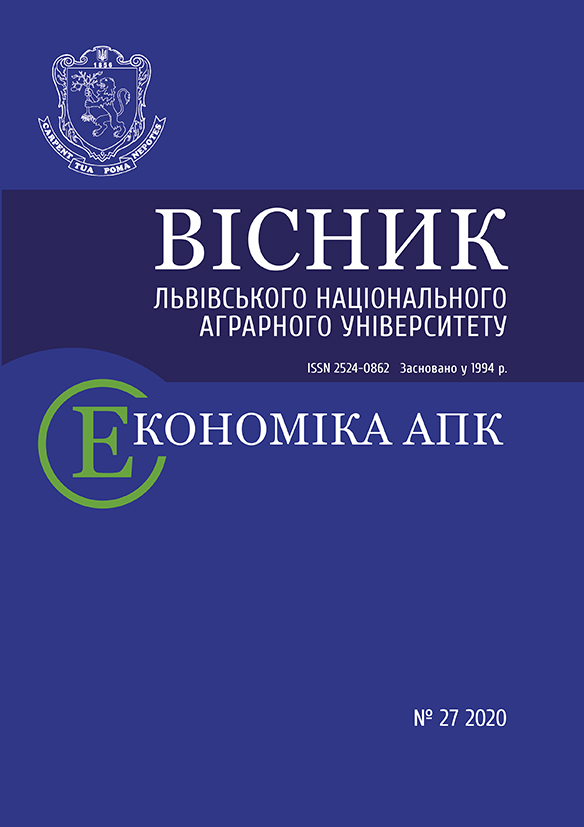Visnyk LNAU: Agronomy 2020 №24: 93-98
Influence of the new complex mineral fertilizer Nitroammophoska-M on the yield and quality of parsnip
I. Dydiv, Candidate of Agricultural Sciences
ORCID ID: 0000-0001-8605-1092
O. Dydiv, Candidate of Agricultural Sciences
ORCID ID: 0000-0003-4155-5945
A. Dydiv, Candidate of Agricultural Sciences
ORCID ID: 0000-0002-4436-9008
M. Yuzkiv, Master of Science
ORCID ID: 0000-0001-9904-7586
Lviv National Agrarian University
L. Hajko, Master of Science
ORCID ID: 0000-0001-5293-8402
Siedlce University of Natural Sciences and Humanities
https://doi.org/10.31734/agronomy2020.01.093
Annotation
Parsnip plants need a set complex of elements for their full-fledged growth and development. One of such fertilizers, which combines macro- and microelements, is a new domestic complex mineral fertilizer of prolonged action called Nitroammophoska-M.
The Nitroammophoska-M fertilizer was used in the form of water-soluble granules. The research results confirmed, that at growing parsnips on the crests, the use of complex mineral fertilizers Nitroammopphoska M at norm N54P108K132 secured the highest yield – 50.1 t/ha, that exceeded control (without fertilizer) by 14.8 t/ha or 41.9%. The studies have shown that, the application of Nitroammophoska-M at norm N36P72K88 result in the yield of parsnip roots at the level of 46.9 t/ha, which was by 1.5 t/ha less than the norm N72P144K176. Applying high norms of fertilizer Nitroammophoska-M, the researchers note a tendency to reduction of the yield of parsnips. The highest yield of marketable roots parsnip (91 and 92 %) was obtained in the variants when mineral fertilizers were applied in the norms N36P72K88 and N54P108K132 kg/ha active substance.
The complex mineral fertilizer Nitroammophoska-M improves the quality of parsnip roots, in particular, the highest dry matter content (20.8 %) is obtained by applying the norm N54P108K132. The highest concentration of total sugar (12.1%) is obtained by applying a complex mineral fertilizer at norm N54P108K132. It is worth noting that application of Nitroammopghoska-M causes the concentration of ascorbic acid varies from 21.5 mg/100g (N54P108K132) to 18.6 mg/100 g (N72P144K176), remaining 17.6 mg/100 g in control (without fertilizers). The level of nitrate nitrogen in all variants of the experiment did not reveal the maximum allowable concentration. The lowest nitrate concentration was in the variant of application of Nitroammophoska-M at norm of N18P36K44 kg/ha of active substance.
Key words
parsnip, Nitroammophoska-M, yield, marketability, quality, nitrates
Link
- Dospekhov B. A. Methods of field experience (with the fundamentals of statistical processing of the research results). Moscow, 1985. 351 p. (In Russian).
- Dydiv І. V., Dydiv O. Y., Dydiv A. I. Nitrates in vegetables. Plantator. Kyiv: AGP Media, 2017. № 5 (35). P. 16–19. (in Ukrainian).
- Dydiv І. V. Influence of foliar feeding with microelements on yield and quality of parsnip in the conditions of the Western Forest-Steppe of Ukraine. Vegetable and melon growing. Kharkiv, 2011. № 57. P. 141–145. (in Ukrainian).
- Dydiv І. V. Influence of growth regulators on parsnip productivity. Scientists Lviv National Agricultural University – for production: catalog of scientific developments / ed. by V. V Snitinskyi. Lviv: Lviv National Agrarian University. 2009. Issue № 9. P.152–153. (in Ukrainian).
- Dydiv І. V. Influence of mineral fertilizers on yield and quality of parsnips. (1998). Bulletin of the Lviv State Agrarian University: agronomy. Lviv. № 2. P. 280–283. (in Ukrainian).
- Dydiv І. V. Productivity and storage suitability of parsnips depending on the fertilizer in the Pre-Carpathian conditions. Theory and practice of development of agro-industrial complex and rural areas: materials XVIII International scientific-practical forum (September 20–22, 2017, Lviv). Lviv, 2017. P. 196–201. (in Ukrainian).
- Hospodarenko H. M. Fertilization of agricultural crops. Kyiv: Vyshcha osvita, 2010. 181 p. (in Ukrainian).
- Nurzylnski J. Nawozenie roslin ogroddniczych. Lublin: Wydadawnictwo A. R., 2013. 179 s. (in Polish).
- Pozniak O. V. New competitive parsnip variety Stimulus. Vegetable and melon growing. Kharkiv, 2010. № 56. P. 13–17. (in Ukrainian).
- Research methodology in vegetables and melons growing. Kharkiv, 2010. 369 p. (in Ukrainian).
- Sady W. Nawozenie warzyw polowych. Krakow: Plantpress, 2012. 267 s. (in Polish).
- Vendylo H. H., Petrychenko V. N. Fertilization of vegetable and melon crops on the homestead: directory. Moscow: Ahropromizdat, 1990. (In Russian).



